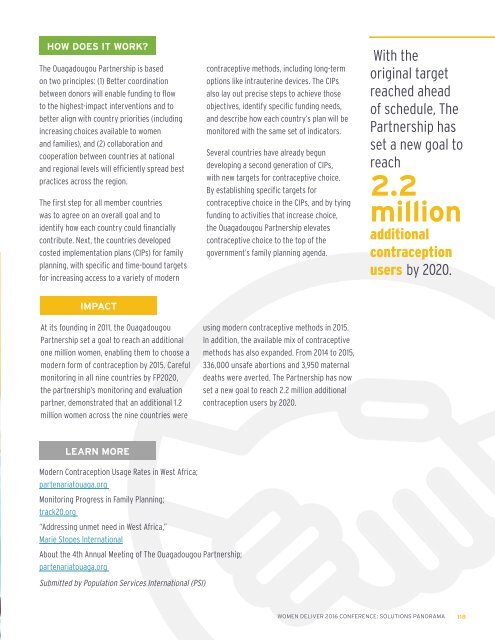Solutions Panorama
A collection of 100 programs, initiatives, and strategies that were shared at the Women Deliver 2016 Conference.
A collection of 100 programs, initiatives, and strategies that were shared at the Women Deliver 2016 Conference.
Create successful ePaper yourself
Turn your PDF publications into a flip-book with our unique Google optimized e-Paper software.
HOW DOES IT WORK?<br />
The Ouagadougou Partnership is based<br />
on two principles: (1) Better coordination<br />
between donors will enable funding to flow<br />
to the highest-impact interventions and to<br />
better align with country priorities (including<br />
increasing choices available to women<br />
and families), and (2) collaboration and<br />
cooperation between countries at national<br />
and regional levels will efficiently spread best<br />
practices across the region.<br />
The first step for all member countries<br />
was to agree on an overall goal and to<br />
identify how each country could financially<br />
contribute. Next, the countries developed<br />
costed implementation plans (CIPs) for family<br />
planning, with specific and time-bound targets<br />
for increasing access to a variety of modern<br />
contraceptive methods, including long-term<br />
options like intrauterine devices. The CIPs<br />
also lay out precise steps to achieve those<br />
objectives, identify specific funding needs,<br />
and describe how each country’s plan will be<br />
monitored with the same set of indicators.<br />
Several countries have already begun<br />
developing a second generation of CIPs,<br />
with new targets for contraceptive choice.<br />
By establishing specific targets for<br />
contraceptive choice in the CIPs, and by tying<br />
funding to activities that increase choice,<br />
the Ouagadougou Partnership elevates<br />
contraceptive choice to the top of the<br />
government’s family planning agenda.<br />
With the<br />
original target<br />
reached ahead<br />
of schedule, The<br />
Partnership has<br />
set a new goal to<br />
reach<br />
2.2<br />
million<br />
additional<br />
contraception<br />
users by 2020.<br />
IMPACT<br />
At its founding in 2011, the Ouagadougou<br />
Partnership set a goal to reach an additional<br />
one million women, enabling them to choose a<br />
modern form of contraception by 2015. Careful<br />
monitoring in all nine countries by FP2020,<br />
the partnership’s monitoring and evaluation<br />
partner, demonstrated that an additional 1.2<br />
million women across the nine countries were<br />
using modern contraceptive methods in 2015.<br />
In addition, the available mix of contraceptive<br />
methods has also expanded. From 2014 to 2015,<br />
336,000 unsafe abortions and 3,950 maternal<br />
deaths were averted. The Partnership has now<br />
set a new goal to reach 2.2 million additional<br />
contraception users by 2020.<br />
LEARN MORE<br />
Modern Contraception Usage Rates in West Africa;<br />
partenariatouaga.org<br />
Monitoring Progress in Family Planning;<br />
track20.org<br />
“Addressing unmet need in West Africa,”<br />
Marie Stopes International<br />
About the 4th Annual Meeting of The Ouagadougou Partnership;<br />
partenariatouaga.org<br />
Submitted by Population Services International (PSI)<br />
WOMEN DELIVER 2016 CONFERENCE: SOLUTIONS PANORAMA 118



